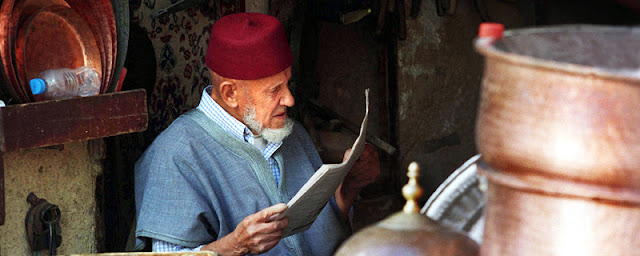Millions of dollars being spent on teaching Moroccans to make pottery? At first glance it looked like a joke. But no, on further investigation it turned out to be at least partially true. The idea that Morocco, famous for its pottery needed lessons would seem both fanciful and patronising. Yet pottery lessons were set up, a translator hired and classes got underway...
Things did not go well. Even with millions of dollars in the budget the translator was second rate and failed to understand the English pottery teacher's language and the teacher tried to impose techniques that required materials not available in Morocco. It would have made a mildly amusing comedy sketchThis woeful tale of misguided US aid, came to light when former Georgia Secretary of State and U.S. Senate candidate Karen Handel started an “Only in Washington” website highlighting government waste. Handel posted this item on Aug. 7, 2013.
Former Georgia Secretary of State Karen Handel has taken her campaign to rein in wasteful government spending to another level. Handel began a daily blog, titled "Only in Washington," detailing alleged wastefulness by the federal government. Handel said. "While Morocco is no doubt a lovely place, we have families in Georgia that are being hurt by high taxes fuelling out of control spending … What’s worse is that the program was deemed a failure …," she continued.
Almost $27 million for pottery classes? And in Morocco, renowned for its ceramics?
A key part of the project included training Moroccans to create pottery to sell domestically as well as internationallyThe investigative website, PolitiFact, took a look at Handel's claims and found them to be more than a slight distortion of the facts.
According to PoltiFact, much of the background about Handel's claim originated from a similar aggregation of alleged wasteful federal government spending done by U.S. Sen. Tom Coburn. Each year, the Republican senator from Oklahoma releases an oversight report of "unnecessary, duplicative and low-priority projects spread throughout the federal government" in a document called the Wastebook.
Coburn’s Wastebook 2012 highlights the pottery classes as an example of wasteful spending, but notes that only part of the $27 million of a U.S. Agency for International Development (USAID) project went toward the classes.
In 2009, USAID began a $30 million, four-year plan to help increase the economic competitiveness of Morocco. The plan included five projects, with the Morocco Economic Competitive Project accounting for $27 million, or 90 percent of the overall plan. The Competitive Project, scheduled to run through Sept. 30, 2013, initially included a provision for a $7 million, one-year extension. But because of anticipated budget cuts, a change in mission strategy, complications with the task order and poor implementation of some activities, it is unlikely the project will be extended, according to a December 2011 audit report by a federal inspector general.
The initial goals of the project were to improve the country's business climate, work on ways to use water sustainably for agricultural growth and strengthen workforce development. A key part of the project included training Moroccans to create pottery to sell domestically as well as internationally.
But the pottery program was riddled with problems that verge on the surreal. For example, a translator hired to translate the instructions from an English-speaking pottery trainer to Arabic-speaking attendees was not fluent in English, which resulted in communication breakdowns. Also, some of the materials used by the pottery trainer were unavailable in Morocco, and participants were unable to replicate the projects. The pottery trainer was seemingly unaware of Moroccan artisanal skill with ceramics.
Ultimately, the audit found that the pottery portion of the competitiveness project was poorly implemented, had limited impact and its intended focus on women and youths was not fulfilled.
It seems astounding that the well-meaning folks in Washington didn't do a little research before designing the program. Even a cursory investigation would have shown them that Moroccan pottery is a reflection of the history of the country. The duality between the Berber heritage and Moorish influence is seen in the techniques, patterns and decorations that adorn the clay objects.
Since the 19th century, artists such as Mohammed Langassi and Boujmaa El Lamali have perpetuated this ancestral craft by giving it a new dimension, propelling the Moroccan pottery to acclaim worldwide.
Very early in the history of mankind clay was used to make utilitarian objects. Since Neolithic times, the Berbers have manufactured rustic pottery using the technique of coiling, a manufacturing process widespread in the Mediterranean basin.
Not until the 5th century BC during Carthaginian rule did the technique spread furrther. With the Roman era (2nd century BC -7th century AD.) the processes were refined and terra sigillata, pots and objects began to be glazed.
Moroccan glazed ceramics date from 814 AD. At that time Idriss II, welcomed thousands of immigrants to Fez from Cordoba among whom were experienced craftsmen skilled in the art.
There are several major categories of Moroccan pottery - town pottery, primarily the magnificent ceramics manufactured in Fez, Safi and Salé. Then there is distinctive pottery from the rural north and south of Morocco, which were for designed for utilitarian purposes such as cooking and storing water or olive oil.
We respectfully suggest that the Moroccan government allocates some money to send some Moroccan artisans (and a good translator) to the USA to teach them how to make pottery. It certainly would cost a fraction of what the Americans spent.
SHARE THIS!




It seems that US taxpayers spent only 18,700,000 dirhams ($2,200,000) on the "mismanaged, poorly organized and ineffective" pottery lessons. Meanwhile, my sister, a math teacher in a public school in the US, has to buy textbooks for her students because the school "can't afford them". Pretty crazy. But AID projects are about politics, not about using money effectively and efficiently.
ReplyDelete